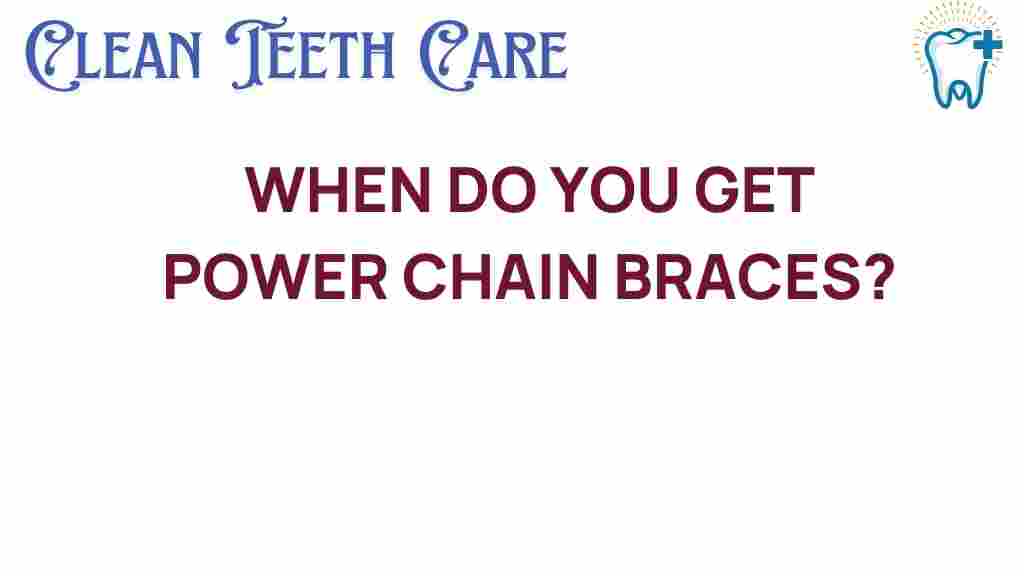Unlocking the Secret: When Should You Get Power Chain Braces?
When it comes to orthodontics, many patients are often faced with a multitude of options for achieving their dream smile. One such option is power chain braces, a powerful tool in the realm of dental care. But when should you consider this specific type of braces treatment? In this article, we will explore the ins and outs of power chain braces, their benefits, and the ideal scenarios for their use, ultimately guiding you toward making an informed decision about your oral health and smile enhancement.
Understanding Power Chain Braces
Power chain braces are a specific type of dental appliance used in orthodontics to help with teeth alignment. They consist of a series of connected elastic bands that are attached to the brackets on your braces. This interconnected system creates a continuous force that can effectively close gaps between teeth, shift teeth into better alignment, and enhance the overall effectiveness of braces treatment.
How Do Power Chain Braces Work?
Power chains exert pressure on the teeth, guiding them into their appropriate positions. Here’s a breakdown of how they function:
- Connection: The power chain is connected to the brackets on your braces.
- Force Distribution: It distributes consistent pressure across multiple teeth.
- Gap Closure: It is particularly effective for closing gaps and spaces.
- Alignment Correction: It aids in correcting misalignments and improving overall dental aesthetics.
When Should You Get Power Chain Braces?
Deciding when to opt for power chain braces involves understanding your specific dental needs and the recommendations of your orthodontist. Here are some scenarios where power chain braces may be the right choice:
1. Closing Gaps Between Teeth
If you have spaces or gaps between your teeth, power chains can be instrumental in closing these openings. They apply force that gradually moves the teeth together, promoting better alignment and a more cohesive smile.
2. Correcting Misalignments
Power chains are often used in conjunction with traditional braces to correct various types of misalignments, including:
- Overcrowding: When teeth are too close together, power chains can help create space.
- Overbites and Underbites: They can assist in adjusting teeth that protrude or are recessed.
- Crooked Teeth: The continuous force helps in straightening teeth that are not in their ideal position.
3. Enhancing the Effectiveness of Braces Treatment
Power chain braces are often used to enhance the overall effectiveness of braces treatment. They can speed up the process of teeth movement, making your journey to a perfect smile shorter.
4. Following Tooth Extraction
After a tooth extraction, power chain braces can be used to close the resulting gap. This is particularly important for maintaining proper alignment and preventing neighboring teeth from shifting out of place.
Steps Involved in Getting Power Chain Braces
Getting power chain braces is a process that typically involves several steps:
Step 1: Initial Consultation
Your orthodontic journey begins with an initial consultation, where your orthodontist will evaluate your teeth and discuss your goals for treatment. This step is crucial for determining if power chain braces are suitable for you.
Step 2: Treatment Plan Development
Once your orthodontist has assessed your needs, they will create a personalized treatment plan. This plan may include the use of power chains, depending on your specific alignment issues.
Step 3: Application of Braces
If you’re not already wearing braces, the next step is to have them applied. Your orthodontist will fit brackets to your teeth and connect them with wires.
Step 4: Installation of Power Chains
After your braces are in place, the orthodontist will attach the power chains to the brackets. They will ensure that the chains are properly fitted to provide the necessary pressure for effective treatment.
Step 5: Regular Adjustments
Throughout your treatment, you will have regular check-ups with your orthodontist. During these visits, they will adjust the power chains and monitor your progress to ensure optimal results.
Troubleshooting Tips for Power Chain Braces
While power chain braces are effective, patients may encounter some issues during their treatment. Here are some common troubleshooting tips:
1. Discomfort or Pain
It’s normal to experience some discomfort after getting power chains. Here are a few tips to alleviate pain:
- Take over-the-counter pain relief medication as directed.
- Use a warm saltwater rinse to soothe your mouth.
- Stick to soft foods until the discomfort subsides.
2. Broken Power Chains
If a power chain breaks, contact your orthodontist immediately. They can schedule an appointment to replace it and ensure your treatment stays on track.
3. Difficulty Eating
Eating with power chain braces may require some adjustments. Consider the following:
- Opt for softer foods that are easier to chew.
- Avoid sticky or hard foods that can damage the power chains.
- Cut food into smaller pieces to make chewing easier.
Conclusion
Power chain braces are a valuable option in the world of orthodontics, offering numerous benefits for those seeking teeth alignment and smile enhancement. By understanding when to get power chains, how they work, and the steps involved in the process, you can make informed decisions about your dental care.
Whether you’re looking to close gaps between your teeth, correct misalignments, or enhance the effectiveness of your braces treatment, power chain braces may be the solution you need. Always consult with your orthodontist to determine the best course of action for your unique oral health needs.
For more information on orthodontic options and dental care, visit this resource. Remember, your journey to a perfect smile begins with the right information and professional guidance!
If you have further questions about dental care and braces treatment, feel free to reach out to your orthodontic specialist for personalized advice.
This article is in the category Treatments and created by CleanTeethCare Team
